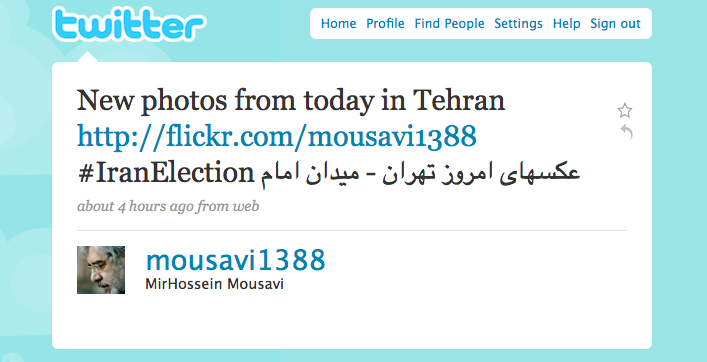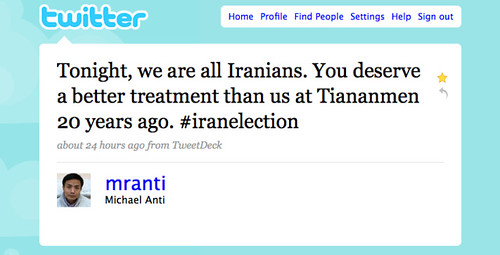“I think the filters and the restrictions have been going on for so long in Iran that the experienced people are already prepared for this,” said Jon Pincus, a former Microsoft project manager and digital activist who works on projects promoting online freedom.
Iranians dodging internet censorship , Doug Gross, CNN
The OpenNet Initiative’s Cracking down on digital communication and political organizing in Iran is a good summary of the situation there, and their research report has a lot more details. Thus far, at least, the internet is largely routing around censorship: despite severe filtering by the government, Twitter, Facebook, Flickr, and YouTube have played huge roles in the protests.
The Mir Hossein Mousavi میر Øسین موسوی Facebook page is one important example, updated regularly with instructions and requests for help and information. Tuesday, when the sites hosting the “guide to cyber-warfare in Iran” were going down under DDoS attacks, they sent a link to a text version of this to all the supporters. This is a very efficient way to get credible information distributed broadly internationally, in easy-to-forward form — and even when Facebook is blocked in Iran, information can flow back into the country through whatever other channels are open.
Tweets from mousavi1388 and many others play a similar role on Twitter — Twazzup’s Twitter page is an excellent way to follow the discussion. Austin Heap and others have taken the lead in sharing information about proxy servers, which can allow Iranians to avoid internet blocking.  Just as importantly, Iranian Twitterers have consistently talked about how much it means to know that the world is watching — and to hear the expressions of support from all over. Twitter’s proven more resilient to censorship than other channels, so it’s also continued to be a vital source of information for people protecting themselves by using the web anonymously.
Speaking of which: if you need to remain anonymous, Tor can help — there’s a Farsi download page at گمنامی آنلاين : Tor. For bloggers, Global Voices Advocacy’s Anonymous blogging with WordPress and Tor is important reading. There’s a lot more information and many additional tools at sesawe.net, which also has Farsi-language pages. And in Nicholas Kristoff’s New York Times op-ed Tear down this cyberwall! he quotes Shiyu Zhou of the Global Internet Freedom Consortium as saying over 400,000 people are using their software from Iran … pretty astonishing.
And of course there’s social networks’ role in news coverage. With foreign reporters being expelled or barred from reporting, and mass censorship internally, it’s citizen journalism that’s making the difference here: photos on Flickr and Facebook, and videos on YouTube, are being picked up by cable TV and major newspapers. Sites like Tehran Bureau, the bloggers at niacINsight, and journalists like Nico Pitney at the Huffington Post, Andrew Sullivan at The Atlantic, and Robert Mackey in the New York Times’ The Lede are doing amazing jobs of synthesizing and editing the information.
As always, there’s a lot of debate about the importance of social networks — technological triumphalists overstating their influence, naysayers finding excuses to minimize their contributes, balanced analyses in the middle. It’s very easy to get fixed online aspects of the protests and lose site of the bigger picture: hundreds of thousands of people in Iran putting their lives at risk to protest apparent electoral fraud.
So I’d like to close with a couple of links with perspectives that haven’t gotten enough attention. For example:
Look closely at the images of peaceful demonstrations taking place in Iran this week and you will spot thousands of brave women taking to the streets to protest an election they say was stolen. “We feel cheated, frustrated and betrayed,” said an Iranian woman in a message widely circulated on Facebook.
For these wives, mothers, sisters and daughters, their march to oust Iranian President Mahmoud Ahmadinejad has everything to do with their desire for equal rights. These women invested their hopes in Mir-Hossein Mousavi, the presidential candidate who pledged to reform laws that treat women unfairly. As it stands now, an Iranian woman’s testimony in court carries only half the weight of a man’s. Women do not have equal divorce, child custody, or inheritance rights either.
— Dianne Tucker, Iranian women: we feel cheated, frustrated, and betrayed, Huffington Post.
Mandy van Deven’s Twitter, Women, and Protest in Iran on Bitch magazine has a handful of other links with women’s perspectives.
And in Iran protests: t’s not about Twitter, it’s not about us, Sarah Jaffe says it far better than I can:
The most inspiring thing about the protests in Iran isn’t the Twitter part, but the sight of thousands of people crowding the streets, demanding basic democracy in their country.
Indeed.
jon
PS: My post Iran: routing around censorship, blogging anonymously, and following the coverage online on the CFP blog from earlier this week has some additional links, as well as this tweet from Chinese blogger Michael Anti:


Leave a Reply